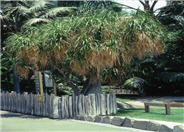
Common name:Pony Tail or Bottle Palm, Beaucarne
Botanical name:Nolina recurvata
This palm-like shrub from the Agave family has a single trunk and grows up to 30' tall. It has thin flat leaves that can grow up to 6' long and only 1" wide. The base is large and distinctive; it usually looks swollen. Mature plants may bloom on a 3'-4' tall stalk.

Common name:Jerusalem Sage
Botanical name:Phlomis fruticosa
This hardy perennial is a useful, old-time garden plant with coarse, woolly gray green, wrinkled leaves and yellow, 1" flowers in ball-shaped whorls. It handles drought and poor soils but needs full sun.

Common name:Goodwin Creek Grey Lavender
Botanical name:Lavandula 'Goodwin Creek Grey'
Lavandula 'Goodwin Creek Gray' is an evergreen shrub. This dense foliaged plant grows to 2.5'-3' high and 3'-4' wide, with silvery leaves that are toothed at the tips. Deep violet-blue flowers bloom from spring to late fall.

Common name:Hybrid Tea Rose (selections)
Botanical name:Rosa Hybrid Tea varieties
These shrubs and vines are the most loved in the Western USA and are very resilient. They come in a wide variety of sizes and colors and are easy to maintain with proper care. They can be used in a water-conserving garden with careful attention to irrigation practices.

Common name:Peruvian Lily, Alstroemeria
Botanical name:Alstroemeria hybrids
The deciduous rhizomes of this Peruvian Lily will often run aggressively if not controlled. They grow best in full to partial sun with some summer watering in dry climates. The florist strains can reach 6' tall, while the compact strains range from 12" 36" tall. For extra long, florist quality stems, stake or grow through netting for support. -Moterey Bay Nursery

Common name:Cecile Brunner Rose (polyantha)
Botanical name:Rosa 'Cecile Brunner'
This climbing rose can grow as tall as 25' with support. It has become one of the most popular roses in cultivation because of its strong display in spring of lightly fragrant flowers that look like tiny, high centered, hybrid tea roses. It is long-lived, disease resistant and tolerates everything from poor soil to partial shade.
| Designer: Shelly Jennings | Shelly's Garden |
Photographer: GardenSoft |
Soils and Compost:
Maintain a two to four inch layer of mulch on the soil surface to reduce weeds, infiltrate rain water, and reduce compaction.
Water Saving Tip:
Check your irrigation controller once a month, and adjust as necessary.
Most plants require only one-third as much water in winter as they do in summer.
Integrated Pest Management:
Remove irrigation water and fertilizer from areas where you don't want weeds to grow.

